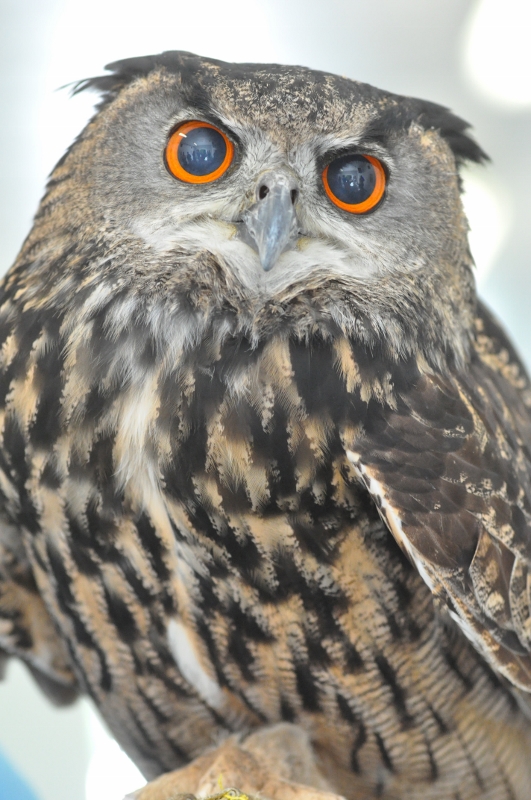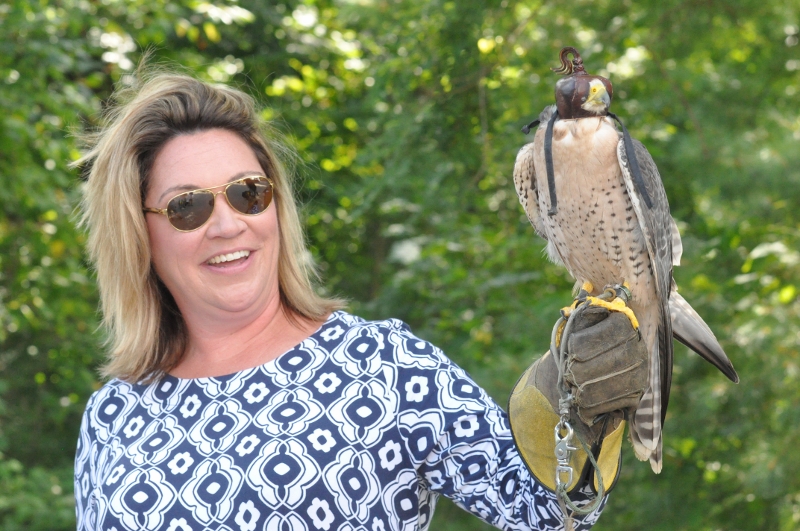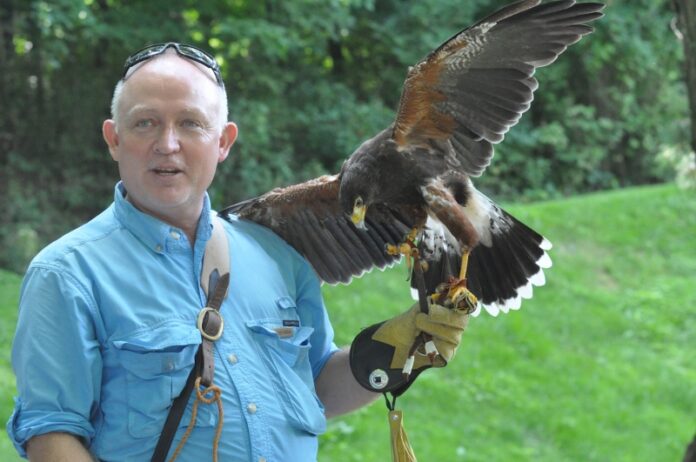
Football, basketball and baseball all have their historical beginnings dating back to the mid-to-late 1800s.
But, a sport that traces its origin to over 3,000 years ago is now enjoying a resurgence less than 2 hours from Roanoke in White Sulphur Springs, West Virginia.
The Sport of Kings is none other than falconry. And, you’ll find this one isn’t necessarily for the birds.
The Greenbrier Resort has continued to expand its falconry program from its inception in the mid-1990s, giving aspiring participants and newcomers alike the opportunity to get a closer look at one of the most unique sporting adventures found anywhere.
Falconry is the sport of hunting wild quarry in its natural state with a trained bird of prey, usually a falcon or hawk. It is also the art of training the bird to hunt in cooperation with a human falconer. The sport is also known as hawking, with both terms synonymous and appropriate regardless of whether a falcon, hawk or eagle is being flown.
Falconry is often considered as the oldest sport still being practiced, although coursing, the sport of running down game with keen-eyed hounds, is actually older. Some evidence suggests that the art of falconry may have begun in Mesopotamia, the earliest accounts dating to around 2,000 BC. Falconry ultimately became a popular sport and status symbol among the nobles of medieval Europe, the Middle East and the Mongolian Empire.

While an experienced falconer does assist his or her raptor in a successful hunt, the falconer is essentially a spectator on the edge of the action. The real players are the birds, which has always been a great part of the appeal – the chance to establish a bond with a wild bird of prey so that it can be handled and observed at close range.
At The Greenbrier Falconry headquarters, head falconer Cody Morgan has an impressive array of 21 birds of prey including falcons, hawks and one of the most magnificent owls, a nocturnal (night) bird of prey, you’ll ever encounter.
Morgan professionally handles the imposing and expansive wingspans of the birds while getting the falconry participants comfortable with being up close and personal among the sharp beaks and talons.
“I loved the outdoors, so I applied, went through an apprenticeship and trained to meet the requirements of a falconer,” Morgan, who began in 2000, explained. “One of the main things is how to deal with people. You have to be able to read the group to know what to expect once we get out and fly the birds.”
Falconry is for all ages and all walks of life. “I’ve had little ones less than a year old, all the way up to older seniors in the classes,” Morgan notes. “It’s good time fun. People get interested in trying it because of falconry being so unique and so historical. There are few places that offer falconry, and it can be a once in a lifetime experience. We offer it all 12 months throughout the year, and I have to say the interest here has been very consistent for many years. I’ve had New Orleans Saints quarterback Drew Brees and PGA golfer Bubba Watson show up for the class.”
During the session, Morgan has the birds flying within inches of the heads of members of the class, swooping in with majestic fashion from the tops of trees. It doesn’t take Morgan long to get most of the class comfortable and having a great time, posing with the bird perched on their glove.
The falconry bird responds to the falconer not out of affection, but because it has been trained to associate the falconer with food. The art of falconry provides the techniques for forming that bond. By controlling the bird’s appetite and by teaching the bird to regard the falconer as its only source of food, the falconer modifies the bird’s behavior.

Once the bird accepts the falconer as the food supplier, the rewards, usually chunks of chicken, prompts a tethered bird to fly short distances and return to the glove for the meal. When the bird eventually returns to the falconer without hesitation, the bird can be taken out into fields and trees to be flown free.
In the true hunting of falconry, the bird, which already hunts by instinct, eventually learns to watch the falconer, who will “put up” game by driving it out into the open.
Birds of prey come in about 280 species, ranging in size from massive eagles to minute falconets the size of a songbird. However, only a handful of species make good falconry birds. The eyesight of the eagle may be the sharpest in the world but Falcons have long been considered the most desirable of the falconry birds because of their speed, dash and trainability.
The fastest animal on the planet is the peregrine falcon in a headlong dive called a “stoop.” This is the species with a long history of being flown by aristocrats. The red-tailed hawk which is indigenous to Virginia, and a workhorse at The Greenbrier, is a big, powerful and easy-going bird. Eagles, because of their great size, power and legal restrictions, are rarely used by falconers.
Equipment in falconry is likewise unique. The “jess” is a leather strap attached to the bird’s legs, allowing control by the falconer. Bells are attached to a trained raptor’s legs to ring different tones that alert the falconer to the bird’s position. A leather hood is placed over a trained raptor’s head to cover its eyes and keep it calm.
Medieval falconers used hooded falcons as props since the hooded birds, a symbol of the aristocracy, would stand virtually motionless on the falconer’s glove, and could be carried to accompany owners to court, into banquet halls and even into church. The gauntlet, the thick leather glove traditionally worn on the left hand, accommodates the huge feet and talons of the bird. In older times, this made the falconers’ right hand free for a sword during the hunt.
According to Morgan, falconry is alive and well and nothing could provide more proof than England’s Bentley Motorcars latest Bentayga Falconry Edition. The Bentayga delivers the pinnacle of luxury for the falconer. It is fitted with falcon perches on the driver console, a master flight station, refreshment station, GPS bird tracking unit, binoculars and hand-crafted leather bird hoods and gauntlets, as well as a veneered falcon crest, blankets and face cloths, plus hide-trimmed interior. All for $230,000 plus extras.
The Sport of Kings indeed – and an historical trip back in time and an experience of a lifetime at The Greenbrier Resort Falconry.
Bill Turner

